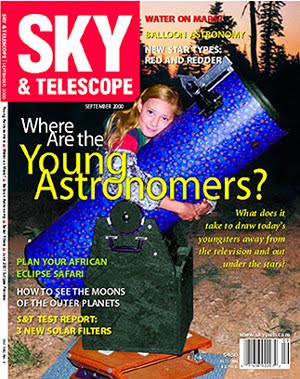Saturday the 8th of January, I met several local bay area observers at the property of Michelle Stone, outside Mariposa California, near the southern end of the Gold Country's main thoroughfare, highway 49. This is a beautiful area, very popular during summer months, and is one of the main portals to Yosemite National Park. Michelle has built the Dale Jay Steed Observatory - a wonderful roll-off roof facility on a south facing hillside, above the fog line and below the snow line. Several scopes were set up around the observatory Saturday night.
I had been waiting for a chance to observe objects in some of the winter constellations. Over the past few years, California has had poor weather due to El Nino and La Nina, so my project, observing the Herschel List, has large gaps in the winter and early spring. I had finished off several constellations by logging the remaining dim stragglers in Vulpecula, Pisces, Perseus, Auriga, Taurus, Canis Major and Monoceros in recent observing sessions, and I had just started and completed Fornax and Lepus. However, much awaited in the rich galaxy fields of Coma Berenices, Ursa Major, Virgo, Leo Minor and Leo (all of which I have begun, but not completed). I noticed that the night's clouds were staying south of the area between Ursa Major and Gemini as the night grew dark. So that would be my target... the area encompassing the little known constellation Lynx. This area too was a continuation, of observing sessions begun in December last year.
I was using an 18" f/4.5 Obsession with a 20mm Nagler, 22mm Nagler type 4, and 12mm Nagler. The sky conditions were maybe 4 of 10 on average do to the clouds, but when there were breaks, the transparency was quite good.
I started with NGC 2552. This is a round galaxy, appearing fairly large and almost translucent, somewhat like the Ring Nebula but filled in enough to "close the hole". Several distinctive stars at mid mag 8 sat just outside the perimeter of the 20mm field. The galaxy, a dim mag 12.1 due to its rather generous 3.5'x2.2' size... its surface brightness (sb) down at about mag 14.2. A dim chain of stars forming a small Cassiopeia shaped W stands just off the galaxy toward the NW.
NGC 2532 sits almost directly on the junction of the boundary lines for Lynx, Cancer and Gemini. It is like most of Lynx, somewhat of a no-man's land from a bright star standpoint. Still, with the help of the known size of Telrad circles and bright stars in Gemini and Ursa Major, this object may be found. The galaxy is almost round, at about 2' in size. It is a bit easier to detect than NGC 2552, but still dim (in these conditions). It might be spiral, but even at higher mag it was not giving much detail. It is listed at mag 12.4 and sb in the low 13's, but on a good night this one would jump out like a light bulb.
I went on to NGC 2649, very difficult to locate as it has no bright stars nearby. I had to use averted vision to "detect" several dim stars that would just bracket my Telrad outer circles. I would put the stars naked eye at about mag 5.8. There is not much to say about this galaxy, other than it is of fairly average size (about 1.5x1.5) and bright. At mag 12.3 with a similar sb.
NGC 2778 is a nice round galaxy about 1.5'x1.0' with its major axis NE/SW, shining at mag 12.4 with similar sb. A nice pair of mag 11 stars separated by 1' sit 6' to the north, and a mag 8.5 star 16' to the east. Under better conditions, three more galaxies would be within the field of view. The galaxy is very easy to locate in the SE corner of Lynx, where a Telrad's outer 4 degree circle sits touching the two mag 3 stars at the southern end of the constellation.
NGC2798 is fun. It, along with its close companion NGC 2799 form Arp 283. Also observed in the same field was UGC 4904, a mag 14.8 galaxy 6' south of the Arp pair. The two galaxies' major axes are NNW/SSE for 2798, which is 2.6'x1.0', and WWNW/EESE for the dimmer and smaller 2799. A few degrees east of the galaxy pair sits a notable close double star mag 8.5 and 9.4.
Moving on to NGC 2329, it is relatively easy to locate the field using a few of the brighter stars in the south of Lynx and the pair of mag 3 stars that form the front "foot" in Ursa Major. The field appears as almost round and smallish at 1.2'x1.2'. It is listed in a few sources a stellar, however I note a small glowing disk. This one's surface brightness is nearly as bright as it magnitude, 12.7 and 12.5, which is understandable due to its small size. There was little difficulty picking it out of the surrounding star field Almost 3' to 2329's east sits dimmer UGC 3696, another roundish galaxy at mag 13.8. In a good dark sky, four galaxies would form a nice chain in this field, with others dotting the periphery.
The field containing NGC 2719, 2719A and NGC 2724 was probably my favorite view of the night. Using the stars at the southern end of Lynx, you can form a right angle using a Telrad to virtually drop on the correct field. This group is also cataloged (2719 and 2719A) as Arp 202. The brighter and larger of the pair is NGC 2719, a nice slash of light at 1.3'x.3' that has a surface brightness of 11.9, notably brighter than the visual magnitude of 13.1. The major axis runs NE/SW, and appears intersected near its SW end by the companion NGC 2719A. 2719A is small, and at lower power seems to be a piece of the larger and brighter primary galaxy. With higher magnification the galaxies become individually more distinct. 2719A sits in a N/S orientation on the south side of 2719. Along with these two, NGC2724 is about 11' to the east, just beyond a mag 10.3 star. The field also has a bright star about mid mag 6 about 25' WNW of the Arp group, and a chain of stars to their east that bracket NGC 2724. This is a very nice field with lots of eye appeal.
About 6 degrees NE of NGC 2719 is NGC 2844. This would be my final Herschel target for the night, as clouds were again beginning to appear on the northwestern horizon. NGC 2844 is has a lenticular shape, measuring 1.6'x.8' in angular size, and having identical magnitude and surface brightness of 13.0. A pair of mag 7 stars are in the field of view, sitting equidistant to the east and north of the galaxy roughly 10' away. The brighter of the two stars has a nice curved chain that straggles away from the galaxy first to the north, then to its west. This distinctive chain, along with the bright stars, makes certain identification of the galaxy easy. It never fails to amaze me how different catalogs diverge in descriptions of object. The description used in Software Bisque's
The Sky calls NGC 2844 a round galaxy, yet it shows the dimensions as 1.5' x 0.7'. Does that sound round to you? The information I am using, provided by Steve Gottlieb, agrees with the dimension, yet catalogs the object as a type Sa galaxy. Strange, but after observing the object, I'll go with Steve's classification. In the field with NGC 2844 were two other objects, NGC's 2852 and 2853, a pair of galaxies about 20' east of 2844. 2852 is smaller in angular size than 2853, a nice round 0.9'x0.8' compared to 1.7'x0.8', and both have nearly identical visual mag of mag 13.2 and 13.3 respectively. These two galaxies are a good example of how distended objects have lower surface brightness than compact ones of equal magnitude, since the sb of 2852 is 12.6 compared to 2853's 13.6.
As the clouds rolled in, appearing like evenly timed waves intruding from the north, and from east appearing as rays illuminating the sky from a soon rising sun, even though sunrise was hours away, we began looking at big bright objects. M42, M65/M66/NGC 3268, etc. It was a nice way to finish of a good but shortish night in the gold country foothills.
After a bit of talking about Plettstone, compared to other observing sites, Michelle turned in, and Ken and I each got into our trucks to sleep. There had been ice on some of our equipment, so the temps were a might chilly, but with proper clothing and adequate sustenance to bolster our resistance, we all had a fine, enjoyable night.











